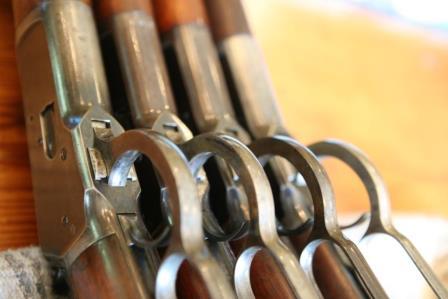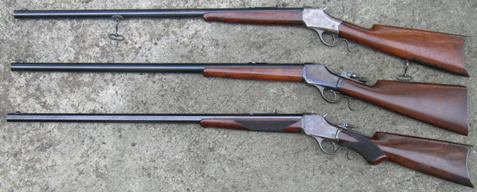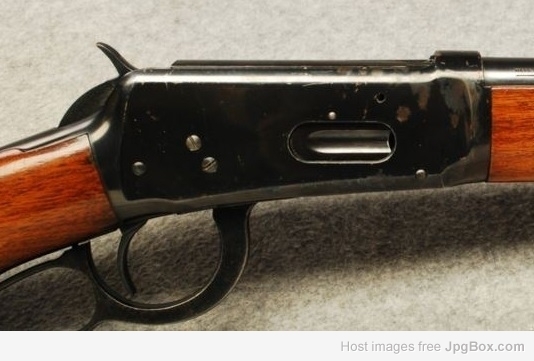Hello jban,
This is a reply which Bert made to a similar question on a different forum:
The “W” stamp was a special marking that Winchester used for a relatively short period of time to test a new bluing formula that they first began using in February of 1939. The previously used bluing formula had proved to be inadequate, and resulted in the bluing flaking off of the receiver frame. Winchester struck the “W” after the bluing process was completed to verify that it did not flake. Winchester discontinued the “W” test stamp in February of 1941 (after 24-months).
Michael

Model 1892 / Model 61 Collector, Research, Valuation
Was it a change in steel alloys that didn’t hold the Carbona? I looked for a W on my 1941 model 63 and didn’t find one, unless it is hidden under the wood or something.
(I reread and see Feb 41 as a cutoff date for the marking and my 63 could easily be out of that range.)
jban said
Was it a change in steel alloys that didn’t hold the Carbona? I looked for a W on my 1941 model 63 and didn’t find one, unless it is hidden under the wood or something.(I reread and see Feb 41 as a cutoff date for the marking and my 63 could easily be out of that range.)
That is my understanding. Supposedly, Winchester increased the Nickel content in the receiver steel alloy (in the year 1919), and it would not hold the bluing.
WACA Historian & Board of Director Member #6571L

Bert H. said
That is my understanding. Supposedly, Winchester increased the Nickel content in the receiver steel alloy (in the year 1919), and it would not hold the bluing.
I have a 95 that looks like nickel or stainless. Smooth as can be, but hardly any blue left anywhere.
Shoot low boys. They're riding Shetland Ponies.
twobit said
Hello jban,This is a reply which Bert made to a similar question on a different forum:
The “W” stamp was a special marking that Winchester used for a relatively short period of time to test a new bluing formula that they first began using in February of 1939. The previously used bluing formula had proved to be inadequate, and resulted in the bluing flaking off of the receiver frame. Winchester struck the “W” after the bluing process was completed to verify that it did not flake. Winchester discontinued the “W” test stamp in February of 1941 (after 24-months).
Michael
I wonder if there wasn’t a short window in the early to mid ’30’s where Winchester didn’t try another bluing process. This is a ’64 with a 1932 production date that must have been one of the first made. The bluing looks like it just about peeled of in spots and instead of being shiny underneath, it’s a dull gray. Maybe it’s just from the environment it’s been in but it sure looks different.
Winchester did not make the change in bluing until the latter half of the 1930s. From 1919 through at least 1934, Carbona bluing was used for the receivers, and your early Model 64 exhibits the classic “flaking” found on the Carbona blued Winchesters.
Bert
WACA Historian & Board of Director Member #6571L

Hello. I see that this thread is pretty old, but I thought I would reply.
I picked up this model 1894 with the W under the serial number, under the barrel being marked 40. 1233704.
I understand the W has to do with a batch of factory reblues. The blueing is interesting as the barrel seems to be different from everything’s.
This is my first post, and I am glad to be here.
Link to photos:
Yellowsevenpot said
Hello. I see that this thread is pretty old, but I thought I would reply.I picked up this model 1894 with the W under the serial number, under the barrel being marked 40. 1233704.
I understand the W has to do with a batch of factory reblues. The blueing is interesting as the barrel seems to be different from everything’s.
This is my first post, and I am glad to be here.
Link to photos:
The “W” is not a result of factory rebluing. Instead, it was a quality control check for a new type of bluing (Du-lite) that Winchester began using in the mid 1930s. In regards to the bluing on the barrel of your Model 94, it has been incorrectly reblued using the holt-salt immersion method (which is what caused the purplish tint).
Bert
WACA Historian & Board of Director Member #6571L

November 7, 2015
 Offline
OfflineWelcome, Yellowsevenpot!
Mike
1 Guest(s)


 Log In
Log In Members
Members Home
Home

 Add Reply
Add Reply Add Topic
Add Topic










